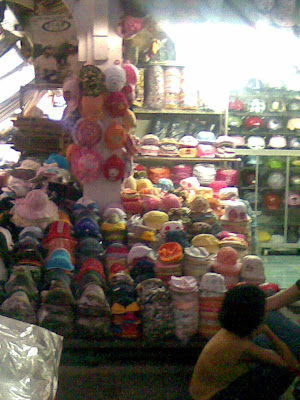Weekend • June 28, 2008
CHRISTIE LOH IN HO CHI MINH CITY
christie@mediacorp.com.sg
.jpg) THE haphazard zig-zag of cars, scooters and fearless pedestrians gradually melts away as you hit the giant bridge between chaos and calm.
THE haphazard zig-zag of cars, scooters and fearless pedestrians gradually melts away as you hit the giant bridge between chaos and calm.It begins to look less and less like the rest of Ho Chi Minh City. Usually-narrow roads that fan into generous lanes. Neat rows of shops shaded by trees evenly spaced out. Tall blocks of offices and apartments covered in glass and steel. “It’s Singapore!”
That was the gut reaction of Dale (who wants to be known only by his first name) when he visited the area three years ago as a potential site for his restaurant, Peaches The Curry Pub. He was instantly charmed. Phu My Hung, an up-and-coming township also known as Saigon South in Ho Chi Minh City, has that effect on Singaporeans.
 A picture of order and sophisticationcompared with the city’s characteristically-congested and litter-strewn streets, the area — designated District 7 — is a reflection of Vietnam’s nouveau riche mintedby the boom that came before the country’s current economic woes.
A picture of order and sophisticationcompared with the city’s characteristically-congested and litter-strewn streets, the area — designated District 7 — is a reflection of Vietnam’s nouveau riche mintedby the boom that came before the country’s current economic woes.When Taipei-based Central Trading and Development Corp (CT&D) teamed up with the Vietnamese government to develop the area in 1993, they were looking at a massive swamp that was a 15-minute drive from the city centre. So, they pledged hundreds of millions of dollars and roped in prestigious American architecture firm, Skidmore, Owings and Merrill, to draw up a master plan. Inspiration for the revamp reportedly were from places such as Hong Kong’s financial centre, Singapore’s Boat Quay area and New York’s Soho. Security posts on every corner
On paper, there were luxurious homes, international schools, an industrial park, a hospital, office buildings, malls and a convention centre, all thoughtfully set in a green, landscaped environment spanning 3,300 hectares. Over the years, those plans came to life. And the joint-venture firm’s name, Phu My Hung — meaning “rich, beautiful and prosperous” in Vietnamese — became synonymous with the township.
 “They organised it very, very well,” said Mr Donald Lee, 40, a Singaporean businessman who moved into the district six years ago with his wife and children. If there were anything that reminded him of home, it was the peace of mind he and his family felt in the district dotted with security posts at nearly every corner. “It’s safer,” said Mr Lee, who has lived in other parts of the city formerly known as Saigon. “It’s the only place you see people park cars on the streets overnight.”
“They organised it very, very well,” said Mr Donald Lee, 40, a Singaporean businessman who moved into the district six years ago with his wife and children. If there were anything that reminded him of home, it was the peace of mind he and his family felt in the district dotted with security posts at nearly every corner. “It’s safer,” said Mr Lee, who has lived in other parts of the city formerly known as Saigon. “It’s the only place you see people park cars on the streets overnight.”Anywhere else in the city, the car’s side mirrors and wheels would have been gone by daybreak, he said. In this neighbourhood known to locals such as Ms Luu Thanh Thuy as “high class”, residents are rich Vietnamese, some of whom are said to have made big bucks from the rocketing property and stock markets over the last two years — as well as expatriates from Korea, Taiwan, South-east Asia and the West. All live in apartments, terraces, customised bungalows, condominiums, villas or townhouses. Catering to them are the many restaurants serving up a taste of their respective hometowns, such as Singapore Food Paradise, and shops offering internationally-known brands including L’Occitane and Gloria Jean’s Coffee.
For Dale, the district’s Park View section reminds him of Singapore’s Holland Village with its pleasant little shops and eateries along sidewalks. US$4,000 Per square metre The metropolitan ambience stands out in a nation that only recently began allowing foreign fast-food chains such as KFC to open, after agreeing to open up the Vietnamese economy in exchange for membership in the World Trade Organisation. But Phu My Hung has been a long time in the making. After getting the licence in 1993 to develop the district, CT&D faced several road bumps:
A high-profile tussle with the Vietnamese government over taxes and an internal company dispute that reportedly involved the 2004 suicide of CT&D former chairman Lawrence Ting.
As late as 2002, Mr Lee said, the town was still “very quiet” — just two rows of villas and two blocks of low-end apartments, he recalled. But when the prices of shares and real estate took off, he witnessed a “rush” to buy up space in District 7. Builders worked faster. At the peak, some homes were going for as much as US$4,000 ($5,451) per square metre, said Mr Lee.
One Singaporean friend, who had bought a villa for US$400,000, was offered US$1.2 million by a Vietnamese two years later. Today, Mr Lee estimates that those exuberant prices have nearly halved. Buyer confidence has dropped on Vietnam’s stock market slump, credit crunch and escalating inflation. But construction continues in Phu My Hung. Houses are still rising from the ground, although several lie vacant, and residents are awaiting the completion of the promised mall, Paragon



.jpg)
.jpg)
.jpg)
.jpg)
.jpg)
.jpg)
.jpg)
.jpg)
.jpg)
.jpg)
.jpg)
.jpg)
.jpg)
.jpg)

.jpg)
.jpg)
.jpg)
.jpg)
.jpg)

.jpg)
.jpg)
.jpg)
.jpg)
.jpg)
.jpg)
.jpg)
.jpg)
.jpg)





.jpg)
.jpg)
.jpg)
.jpg)
.jpg)
.jpg)
.jpg)
.jpg)
.jpg)
.jpg)
.jpg)
.jpg)
.jpg)
.jpg)

.jpg)
.jpg)